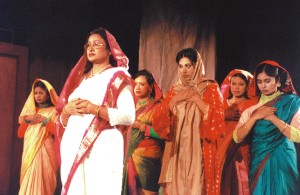Theatre
Natyachakra presents Lorca's play at Mahila Samity Stage
Ershad Kamol
Natyachakra staged its 47th production Bilkisbanur Konnyara, an adapted play from Spanish Federico Garcia Lorca's The House of Benarda Alba, at the Mahila Samity Stage, recently.The House of Benarda Alba is Federico Garcia Lorca's last play, written the year he was killed at the outbreak of the Spanish Civil War. The play, along with Blood Wedding and Yerma, forms a trilogy expressing what Lorca saw as the tragic life of Spanish women. If Blood Wedding is a nuptial tragedy and Yerma the tragedy of barren women, The House of Benarda Alba might be seen as the tragedy of virginity, of rural Spanish women who will never have the opportunity to choose a husband. It is also a play expressing the costs of repressing the freedom of others. Its setting is specific to the values and customs of the rural Spanish people, but the play's appeal is universal rather than national. Golam Sarwar, who has adapted the play, has set The House of Benarda Alba against the backdrop of the social structure of rural Bangladesh through his work Bilkisbanur Konnyara. This powerful drama of seduction and betrayal is a study of family relationships under the strain of culturally and socially imposed sexual taboos. When Bilkisbanu's husband dies, she strives to contain the passions of her five unmarried daughters, but desire prevails in a dramatic culmination of madness and violence. The director, in his note, claims that his aim is to portray the social structure of contemporary Bangladesh-- especially the oppression of women by society, which begins early in life. Girls in our society do not get a chance to express their passion and emotion because of obstacles created by their families. Against this backdrop, director Golam Sarwar has created a fantasy world on stage. The social structure that Sarwar has presented is not found in any region of Bangladesh and his directorial lines need modification. Moreover, he is unable to effectively create the dramatic conflicts between the characters on stage. Zunaid Eusuf's stylish set design presents the interiors of an aristocratic house in the rural areas. His light design is simple but effective. Irin Parvin Lopa's costume design does not go well with the mood and tempo of the play. Performers in the play, except Mili Munshi and Tulika Chowdhury, did not effectively capture the psyche of their characters. Falguni Hamid as the central character, Bilkis Banu, could not fulfill the thirst of the audience. If she had pulled her weight, the play could have been interesting. Tonima Hamid as Abida, a very important character in the play, needs to be more spontaneous on stage.
|

Falguni Hamid (2-L) in the role of Bilkisbanu is seen along with her five daughters in the play |